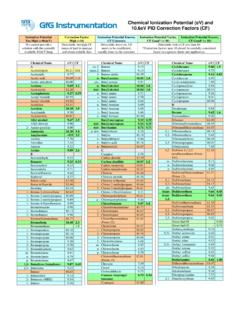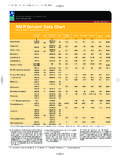Transcription of Sucrose Esters of Fatty Acids - fao.org
1 0 out of 9 FAO/WHO 2017 Residue Monograph prepared by the meeting of the Joint FAO/WHO Expert Committee on Food Additives (JECFA), 84th meeting 2017 Sucrose Esters of Fatty Acids This monograph was also published in: Compendium of Food Additive Specifications. Joint FAO/WHO Expert Committee on Food Additives (JECFA), 84th meeting 2017. FAO JECFA Monographs 20 1 out of 9 FAO/WHO 2017 Sucrose Esters OF Fatty Acids Prepared at the 84th JECFA (2017) and published in FAO JECFA Monographs 20 (2017), superseding specifications prepared at the 73rd JECFA (2010) and published in FAO JECFA Monographs 10 (2010). An ADI of 0 - 30 mg/kg bw for this substance together with sucroglycerides, Sucrose oligoesters type I and type II and Sucrose monoesters of lauric, palmitic or stearic acid was established at the 73rd JECFA (2010).
2 SYNONYMS Sucrose Fatty acid Esters , INS No. 473 DEFINITION Mono-, di- and tri- Esters of Sucrose with food Fatty Acids , prepared from Sucrose and methyl and ethyl Esters of food Fatty Acids by esterification in the presence of a catalyst or by extraction from sucroglycerides. Only the following solvents may be used for the production: dimethylformamide , dimethyl sulfoxide, ethyl acetate, isopropanol, propylene glycol, isobutanol and methyl ethyl ketone. Assay Not less than 80% of Sucrose Esters DESCRIPTION White to greyish white or pale yellow powder, stiff gel or soft solid FUNCTIONAL USES Emulsifier CHARACTERISTICS IDENTIFICATION Solubility ( ) Very soluble in ethanol at 50 Fatty Acids Add 1 mL of ethanol to g of the sample, dissolve by warming, add 5 mL of dilute sulfuric acid TS, heat in a water bath for 30 min and cool.
3 A yellowish white solid or oil is formed, which has no odour of isobutyric acid, and which dissolves when 3 mL of diethyl ether are added. Use the aqueous layer separated from the diethyl ether in the Test for sugars. Sugars To 2 mL of the aqueous layer separated from the diethyl ether in the test for Fatty Acids , carefully add 1 mL of anthrone TS down the inside of a test tube; the boundary surface of the two layers turns blue or green. PURITY 2 out of 9 FAO/WHO 2017 Sulfated ash ( ) Not more than 2% Test 1 g of the sample (Method I) Acid value ( ) Not more than 6 Free Sucrose Not more than 5% See description under TESTS dimethylformamide Not more than 1 mg/kg See description under TESTS Dimethyl sulfoxide Not more than 2 mg/kg See description under TESTS Ethyl acetate, isopropanol and propylene glycol Not more than 350 mg/kg, singly or in combination See description under TESTS Isobutanol Not more than 10 mg/kg See description under TESTS Methanol Not more than 10 mg/kg See description under TESTS Methyl ethyl ketone Not more than 10 mg/kg See description under TESTS Lead ( )
4 Not more than 2 mg/kg Determine using an AAS/ICP-AES technique appropriate to the specified level. The selection of sample size and method of sample preparation may be based on the principles of the methods described in Volume 4 (under General Methods, Metallic Impurities ). TESTS PURITY TESTS Free Sucrose Determine by gas chromatography (Vol. 4) under the following conditions: Standard solutions Prepare a stock solution containing mg/mL of Sucrose in N,N- dimethylformamide . Prepare a range of standard solutions 3 out of 9 FAO/WHO 2017 containing , and mg/mL of Sucrose by dilutions of the stock solution with N,N- dimethylformamide .
5 Internal standard solution Weigh accurately g of octacosane into a 50-mL volumetric flask, add 25 mL of tetrahydrofuran to dissolve the octacosane, and add tetrahydrofuran to the mark. Chromatography conditions - Column: 100%-Dimethylpolysiloxane (30 m x mm with m film) - Carrier gas: Helium - Flow rate: mL/min - Detector: Flame-ionization detector (FID) - Temperatures: o injection port: 280o o column: Hold for 1 min at 100o, then 100-300o at 12o/min, hold for 45 min at 300o o detector: 320o The retention times of free Sucrose and octacosane measured under the above conditions are approx. and min, respectively.
6 Procedure: Weigh accurately 20-50 mg of the sample into a centrifugation tube, add 1 mL internal standard solution, 1 mL N,N- dimethylformamide , mL of N,O- bis(trimethylsilyl)acetamide (BSA) and mL trimethylchlorosilane (TMCS). After sealing the tube, shake and let stand for 5 min at room temperature Inject 1 l into the chromatograph. Standard curve Prepare silylated standard solutions following the above procedure using 1 mL each of the standard solutions in place of the sample and N,N- dimethylformamide . Draw a standard curve by plotting amount of Sucrose (mg) in 1 mL of the standard solution (X-axis) vs. ratio of peak area of Sucrose /internal standard (Y-axis).
7 Measure the peak areas for Sucrose and internal standard. Calculate the ratio of their peak areas, and obtain the amount of Sucrose from the standard curve. Calculate the percentage of free Sucrose from: % = ( ) ( ) 100 4 out of 9 FAO/WHO 2017 dimethylformamide Determine by gas chromatography (Vol. 4) under the following conditions: Standard solutions Prepare a stock solution containing mg/mL of dimethylformamide in tetrahydrofuran. Prepare a range of standard solutions containing , and g/mL of dimethylformamide by diluting the stock solution with tetrahydrofuran Chromatography conditions - Column: Polyethylene glycol (30 m x mm with a m film) - Carrier gas: Helium - Pressure: 150 kPa (constant pressure) - Detector: Nitrogen/phosphorus detector or thermionic specific detector) - Temperatures: o injection port: 180 column: Hold for 2 min at 40 , then 40-160 at 20 /min, hold for 2 min at 160 o detector: 325 - Injection method: Splitless injection of l with auto-injector, followed by start of purge after min.
8 The retention time of dimethylformamide measured under the above conditions is approx. min. Procedure Weigh accurately 2 g of sample into a 20-mL volumetric flask, add 10 mL of tetrahydrofuran to dissolve the sample, add tetrahydrofuran to the mark, and mix the solution well. Inject l of the sample solution into the chromatograph. Standard curve Prepare daily by injecting l of each of the standard solutions into the chromatograph. Calculate the concentration of dimethylformamide in mg/kg (CDFA) from: ( / )= 20/ where 5 out of 9 FAO/WHO 2017 - C is dimethylformamide concentration determined ( g/mL); - W is weight of sample (g) Note: The column must be reconditioned frequently.
9 Overnight reconditioning (flow carrier gas in the reverse direction at 180 without the connection of the detector) is required after about every 15 samples. Dimethyl sulfoxide Determine by gas chromatography (Vol. 4) under the following conditions: Standard solutions Prepare a mg/mL stock solution of dimethyl sulfoxide in tetrahydrofuran. Prepare a range of solutions containing , , and g/mL of dimethyl sulfoxide by dilutions of the stock solution with tetrahydrofuran. Chromatography conditions - Column: 10% PEG 20M and 3% KOH on Chromosorb W AW DMCS 60/80 mesh (2 m x 3 mm ) or equivalent. - Raise the oven temperature to 180o at a rate of 10 /min and let stabilize for 24 to 48 h with 30 to 40 mL/min of nitrogen for conditioning - Carrier gas: Nitrogen - Flow rate: 30 mL/min - Detector: Flame photometric detector (using 394 nm sulfur filter) - Temperatures o injection port: 210o o column: 160o The retention time of dimethyl sulfoxide measured under the above conditions is approx.
10 Min. Procedure Weigh accurately 5 g of the sample into a 25-mL volumetric flask, add 10 mL of tetrahydrofuran to dissolve the sample, add tetrahydrofuran to the mark, and mix the solution well. Inject 3 l of the sample solution into the Standard curve Prepare daily by injecting 3 l of each of the standard solutions into the chromatograph. Calculate the concentration of dimethyl sulfoxide in mg/kg (CDMSO) from: 6 out of 9 FAO/WHO 2017 ( / )= 25/ where - C is dimethyl sulfoxide concentration determined ( g/mL); - W is weight of sample (g). Propylene glycol (Vol. 4) Determine by gas chromatography (Vol.)















